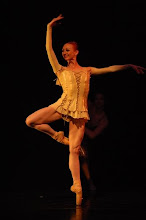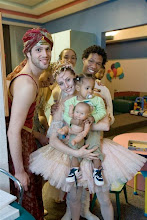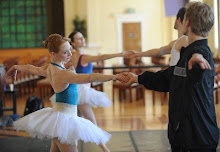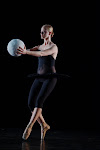—Julie Niekrasz (pictured above in blue), dancer with Ballet Memphis and certified STOTT PILATES instructor
Friday, June 15, 2012
Why Pilates Is Good for You
—Julie Niekrasz (pictured above in blue), dancer with Ballet Memphis and certified STOTT PILATES instructor
Monday, June 11, 2012
 |
| Rachel Choy, Lauren Petrin and Anna Hedgepeth in Matchgirl |
I don't know that this year's group is unusual in their academic prowess, maybe they just talked more around me about where they were applying and where each was accepted. The list is so impressive that I want to take a moment to share it with you. Lest any parents think their child is going to sacrifice her academic future by spending so much time at Ballet Memphis, I offer for their consideration this list of schools to which our senior class not only applied, but here are all the schools to which they were accepted: Auburn University, Boston University, Bowling Green State, Clemson, College of Wooster, Cornell, Duke, Emory, Fordham, Georgetown, Harvard, Mississippi State, Northeastern University, Northwestern, Princeton, Rhodes, Samford, St. Louis University, Texas Christian University, University of Alabama, University of Arizona, University of Arkansas, University of Chicago, UT Knoxville, UT Martin, UT Chattanooga, University of Memphis, University of Michigan, University of Washington, Vanderbilt and Washington University.
I think what's most impressive is how well rounded our dancers are, choosing to pursue studies and careers in my different fields. Rachel Choy graduated from ECS and will attend UT-Chattanooga in the fall. Anna Hedgepeth graduated 6 out of her class of 400 at Houston High and will attend Cornell University where she will double major in society and biology–a major for pre-med students who plan on practicing medicine in third-world countries. Ana Marinovic graduated summa cum laude and was Salutatorian of her class at St. Mary's Episcopal School. Although Emory University awarded her a four-year, full scholarship as an Emory Scholar, Ana has chosen to attend Harvard University. She told me she'd like to double-major in any of the following: government, mathematics, education or creative writing. Leandra Mayfield plans to attend Bowling Green University to major in music and psychology so that she can be an expressive arts therapist. Sarah McFann graduated from Arlington High School as a National Merit Scholar. She'll attend the University of Alabama and major in both dance and chemical engineering. Lauren Petrin graduated from St. Mary's and will major in communications at Boston University. Kristian Swain graduated from Collierville High school and plans on majoring in elementary education at Mississippi State. Jacqueline Beaird also graduated from Collierville High School and will major in Spanish and elementary education at UT-Knoxville.
I couldn't be more proud of the dedication these young women have brought to both their ballet practice at Ballet Memphis, and those around them.
—Janet Parke, Ballet Memphis School Principal
Friday, April 13, 2012
Where is Cinderella in our heart?
This quote by Charles Perrault struck Cinderella’s choreographer, Steven McMahon, as a most appropriate way of describing the real beauty this tale highlights in its lead character, Cinderella. Cultures have used stories through the ages to wrestle with ideas of beauty and ugliness. One idea that has lasted a long time is the need to know who we are, especially if we believe real beauty lies in attaining happiness. The Ugly Stepsisters in Cinderella are funny because they are strong, hairy men pretending to be women. They pretend to be beautiful, but we all know they cannot be until they acknowledge their mean-spirited and dim-witted personalities. The stepsisters offer contrast to Cinderella’s beauty, who serves others thoughtfully and gently. They also allow us to laugh at their weaknesses, precisely because we know we have a bit of them in us. Steven speaks of being struck by how Cinderella never seems to be defined by her environment. She responds with kindness, even when burdened with genuine sorrow, by doing what she knows she has to do. Steven also decided to bring the mother/daughter story into Cinderellain a smart way. Mothering is a tremendous force, and like most forces, it has potential for good and bad. Protecting and nurturing our young is utterly necessary, as is letting them have their space to make their mark. But giving our children the idea that their wants and desires should be placed at the center of the universe is a terrible idea. As we see so clearly in Cinderella,The Wicked Stepmother has bred monsters in her image. Cinderella, however, teaches us that those who give, care and nurture become given to, nurtured, and cared about, which is one of those things in life that never changes. When we participate in the handing down and adaptation of culture, we can glean so much from it if we remember to examine where we fit into the story; if we remain open to the possibilities for transformation.
Where is Cinderella in our heart? She who serves others and helps the needy? When are we as Fairy Godmothers, recognizing good and moving it forward? When do we reward excellence and do the difficult work of demanding it, not settling for the ease of imitative mediocrity? When are we willing to do the work, write the check and put in the time, instead of waiting for someone else to do it for us? Are we going to be Memphis with leaders like the Pharaoh, believing in , supporting and searching for real creativity and beauty? The more we can honestly search our hearts and answer yes the better our lives will be. And I hope we will always have art to prod us, inspire us and push us toward being the better selves we can be.
—Dorothy Gunther Pugh
Wednesday, April 11, 2012
On musicals, Gene Kelly and Swan Lake...
 My parents have always loved watching old musicals. Even at our family Christmas party, my parents, still to this day, get up and sing a song from Showboat together during the talent portion of the evening. Yes, you heard me right, a talent show in the middle of Christmas Eve dinner with 50 relatives watching. So I was constantly surrounded by musicals that I haven’t even seen. I will never forget the day that my parents and I watched An American in Paris with Gene Kelly. I was about 7 years old and in complete awe. I couldn’t believe how he moved his body, his agility, his strength, and of course that face. You fell in love with that smile!! After that night, we rented Brigadoon and of course Singing in the Rain. From then on I was hooked. I knew I wanted to do what Gene did, maybe not in a movie, but to perform. And I knew I had that ability after I had done a few plays at school. I wanted to move like him and touch people in the way his performances touched me.
My parents have always loved watching old musicals. Even at our family Christmas party, my parents, still to this day, get up and sing a song from Showboat together during the talent portion of the evening. Yes, you heard me right, a talent show in the middle of Christmas Eve dinner with 50 relatives watching. So I was constantly surrounded by musicals that I haven’t even seen. I will never forget the day that my parents and I watched An American in Paris with Gene Kelly. I was about 7 years old and in complete awe. I couldn’t believe how he moved his body, his agility, his strength, and of course that face. You fell in love with that smile!! After that night, we rented Brigadoon and of course Singing in the Rain. From then on I was hooked. I knew I wanted to do what Gene did, maybe not in a movie, but to perform. And I knew I had that ability after I had done a few plays at school. I wanted to move like him and touch people in the way his performances touched me.A few years later, I had been taking tap, jazz and ballet lessons. My mom saw that American Ballet Theater was performing Swan Lake in downtown Chicago. We didn’t have tickets, but she thought we would make the drive downtown and take a chance. Sure enough someone who had 5th row seats turned them in at the last minute. My mother bought them and I am so glad she did. That show changed my life.
I remember watching, not even blinking, at how a woman could transform into a Swan. She moved her arms with such fluidity, as if she had wings. It was the most magical and beautiful thing I had ever seen. From that moment, at 12 years old, I made the decision to do everything I could to dance. I didn't know if I could eventually become a professional dancer, but I knew I had to try. I knew I had something inside of me that I had to share. Now, I have made a life and career at Ballet Memphis for the past eight years! So, thank you, Mom and Dad, for taking chances with me, for exposing me to art, for always supporting me and sharing a love for dance.
—Julie Marie Niekrasz Strampe, dancer
Monday, April 2, 2012
Students and company members, together, learning and creating

Throughout my 15 years at Ballet Memphis, I have worked with many teachers. Some have come and gone, and some I have known my entire time here. It was not until I advanced to the higher levels in the school that I started to have guest company-member teachers who would teach once or twice a semester, usually as a substitute or for a workshop class.
I took my very first company-member–taught class in the eighth grade by Steven McMahon. Anyone who is familiar with Steven as a dancer could imagine the immediate intimidation my friends and I felt. Towering over all of us with a serious expression, Steven began his introduction by detailing his experiences at Alvin Ailey, the world-renowned modern dance company in New York City. Needless to say, I was terrified. Who was this Horton he kept speaking of, and why could I never remember the intricate combinations we learned every week in class? (This “Horton,” or Horton Technique developed by Lester Horton, utilizes a whole-body, anatomical approach to dance that includes flexibility, strength, coordination and body, and spatial awareness to enable unrestricted, dramatic freedom of expression.)
I would only get worse before I started making small steps toward understanding and appreciating my discomfort in the class. We continued taking weekly modern classes from Steven, and I can only describe the last five years as one of the most transcending journeys I have encountered thus far. I progressed from the nervous girl who sought to dance in the back, to the person who fights for a spot in the front. I wish I could have seen how important these classes were for my development as a dancer when I first began, but at the same time, I view the struggle that I faced by enduring these classes that much more inspiring.
More recently, company members have begun teaching our ballet classes. Twice a week, they teach our class, including a workshop ranging from pointe variations to Pilates. At the same time, they are able to integrate goals they are striving for in their everyday work and classes into the classes they plan for us.
I love having company members teach our class. I get to watch my own teachers go out onto a stage and exude the same passion and commitment they encourage me to pursue. I can honestly say I have learned more by watching my teachers on stage performing than I think is possible through daily practice in a studio. They have shown us through their own work how to pursue what we love and embrace our artistic abilities in a whole new way.
Aside from regular class, I have had the opportunity to perform with the company in numerous productions of the Nutcracker, once even being granted the honor of understudying and performing as a Snowflake my junior year. What may have seemed like a familiar corps role many company members had performed several times already, was my pride and joy for the few months I attended rehearsals. I was, however, terrified that I was going to mess up or stick out as an obvious student. However, I was faced with nothing but kindness and encouragement from the company women I understudied. I learned so much from my time understudying, and I will always cherish that opportunity as one of great honor and professionalism.
As my time at Ballet Memphis comes to a close when I graduate this year, I also appreciate working with company members who choreograph on us for our Junior Company shows. I have worked with a couple of company members in this atmosphere and enjoyed some of the most fun and most challenging experiences I have had at Ballet Memphis. Aside from getting to know them in a more personal setting, we are challenged to dance outside of our everyday ballet technique and can explore different styles of movement. Learning to work with new choreographers and integrating new repertoire and movement into our dancing allow us to enhance our dance abilities in a way that everyday class cannot.
As we spend more time together—company and students—a different relationship has emerged. At first I attributed the changing relationships to my age and seniority in the school before I realized that the company is not just teaching higher levels anymore. Company members, apprentices and trainees teach younger levels, thus connecting with students of all ages throughout the school.
The Ballet Memphis School is always changing and growing, but I never realized that it might also be changing the relationships between the students and company holistically. Our interactions with teachers and choreographers have opened up opportunities for us to regard them as mentors, role models, and although some of them would refuse to admit it, even friends.
Lauren Petrin (student, left) with dancer Stephanie Mei Hom (right) backstage at Nutcracker.
Monday, March 26, 2012
My dream job

What a dream job I have as Ballet Memphis’ in-house costume designer. I’ve been here for 10 years, having come from the craziness of L.A., to a place where I have been able to really stretch myself as a creator. First, a little bit about me.
I was born in Hoi An, Vietnam, a few years after the Vietnam War ended. I lived there until around age 7, when my parents and I moved to Saigon. Not too long after that, my parents decided to emigrate. After being smuggled in a fishing boat for seven days, we were rescued and became refugees, taking asylum in the Philippines, where my parents processed their paperwork and got accepted to come to America. We ended up living in the San Fernando Valley in California.
I grew up sewing costumes and dresses for family and friends, but I had no idea that there were actually people behind the scenes who made a living creating what goes on the stage and screen. In fact, it was only by coincidence that I stumbled upon this profession. In college, I was going to major in business administration, but while picking out my first-semester courses for freshmen year, I thought I would try at least one fun class. The theatre department had a costume shop that was offering a course, and since I loved to sew, I signed up for it.
That class really opened my eyes and offered so many new opportunities. Since I already excelled in sewing, I ended up working for the department’s costume shop; then I ran the shop for my work-study program. After a lot of soul searching, I eventually changed my major to theatre with an emphasis in technical theatre. When I graduated, I had a decent resume, and continued to freelance with different theatres in Los Angeles. I was never short on projects, and they varied so much that it made for an exciting and sometimes chaotic life as a freelance costume designer.
After deciding that I wanted a calmer pace in life, I thought working full time in a costume shop would be more fulfilling than running around to every corner of Los Angeles every day. Just around the same time, I read that Ballet Memphis had a wardrobe supervisor position available. Ballet Memphis offered to fly me out to interview, and within a week, I had found an apartment in Midtown, flown back to L.A. to pack, and gotten back here to start at Ballet Memphis, all in less than two weeks.
This company is one of the most unique organizations that I have ever worked for, and it is still exciting to go to work every day. I began as the wardrobe supervisor, but am now also the in-house costume designer, and manage the costume shop and shoe stock. Supervising the costume shop at Ballet Memphis is about organizing the multiple shows being mounted, including our mainstage shows, outreach and tour, and junior company shows. If we are re-staging a piece, it is our responsibility to re-create the choreographer’s and the designer’s original intentions. That can sometimes get tricky when we haven’t done that piece for several years. Fabrics can be discontinued, or sewing patterns can be filed away incorrectly, making it difficult to find them.
When we do a new piece, whether I’m designing or a guest designer, we produce an appropriate and cohesive look with the choreographer and construct what is needed (sometime in duplicates for a second cast). It is always a collaborative effort, and the process is different depending on whom and sometimes what material we are working with. I have been fortunate to have designed for a variety of chorographers at Ballet Memphis, some who are dancers themselves in the building, and some who come and create new work on the company. It all starts with an idea, and depending on how each choreographer works through his or her process, our goal is to evolve the ideas as best we can. Sometimes it works from the beginning, and sometimes it becomes a great lesson to note for the next time. Every time, it is about exchanging ideas, and some of the best experiences I’ve had are when I’m open to a different point of view.
I also maintain the shoe stock for the dancers. For the men, that means having the brands, styles, sizes and varieties of color in the shoes they need, and sometimes dyeing them if needed. For the women, that means keeping their stock of pointe shoes consistent. It’s a little more complicated, but we do it. Most of our ladies wear custom handmade pointe shoes, made by a handful of craftsmen in London and elsewhere. The waiting time can range anywhere from three to nine months. Every month, I receive a breakdown of each shoe maker and his or her current waiting time for shoes. Some shoe makers are so popular, they won’t take on any new dancers.
The tricky part is assessing, as best we can, how much pointe work is coming up within the year, how long each shoe maker will take to fill the shoe order, and when to place the order. Taking into consideration that the shape of the dancers’ feet do change, ordering too many shoes at one time is not an ideal option, as they are rather expensive.
From short pieces, to full-evening story ballet, the costume shop always puts a finishing touch to the experience.
Monday, January 23, 2012
Reflecting on AbunDANCE
Ballet Memphis has an abundant history of producing thoughtful programs of the finest curatorial quality, and we celebrate some of that history with you this weekend. AbunDANCE presents the perfect setting. it is, after all, a repertory show, one for which I have selected works that reflect our strongest qualities and showcase the richness of our versatility and our commitment to acquire and perform well-crafted, meaningful work. Each one of these pieces brings to life the ideas and feelings we share together.
At the basis of all that we do at Ballet Memphis, we work as ballet-trained artists. This assures an elegance of bearing and a sense of line that is a strong foundation from which we can depart, often in many directions. Dana Tai Soon Burgess' work, Venetian Reflections, was one of the works created for AbunDANCE: Art in Motion (2009) based on a John Singer Sargent painting at the Dixon Gallery. Its quiet drama and subtle movement vocabulary illustrate the contemporary classical ballets we have created or acquired. It is a fiercely delicate ballet, belying the utter strength it takes to sustain the movement that must be in place to partner with the music's intense fluidity.
Ballet Memphis' own Steven McMahon created Soul Selects Her Society for Interiorworks (2010), an annual dancer-produced season-closer event. We have nurtured many young choreographers, and as our choreographic associate, Steven is one of our success stories. The company has performed his work on stages across America, and it has become part of our most-important and most-danced repertoire. Ballet Memphis does much work to sung lyrics and this was Steven's first foray into this type of piece. He has created more than a dozen works for us and for our Junior Company, so seeing one of his well-crafted, deeply sincere, and first lyric-based pieces is a good way to view is copious talents, and Ballet Memphis' talent for creating significant work through the mentoring of young talent for which we are nationally respected.
Robert Battle, new artistic director for the prestigious Alvin Alley Company, is a longtime friend of Ballet Memphis. I met Robert and saw his solo work, Takademe, years ago when Ballet Memphis was the only American ballet company to be selected to perform in Houston's Dance Salad Festival in 2003. Robert choreographed for us after that for our first Connections series, but it wasn't until AbunDANCE: Joyful Noise that I found a place for Takademe. Ballet Memphis is often the first ballet company to acquire a signature work from well-known modern dance choreographers, and this is one of them. Our commitment to expand our audiences' experiences and our dancers' remarkable athleticism and skill are clearly manifest in this work. Enjoy it fully, as Ballet Memphis is the only ballet company in America with Robert's rights to perform it.
Ballet Memphis is also a company that has a uniquely American persona in its repertoire, its particular physicality, and its open and confident delivery. Over the years we have returned frequently to Mark Godden's glorious Angels in the Architecture, including our first performance in New York in 2000. Angels not only reflects a fascinating piece of American history in the Shaker community, the largest of which was north of us in Kentucky, but it is a bold and compelling work infused with the spirit of the profoundly stirring Aaron Copland score.
I have always felt that the coupling of Mark's poignant choreography with the ecstasy of this iconic American musical suite is a match made in heaven. It takes a very fine ballet company to dance this exacting work. The Shakers, just like those of us who believe in ballet, were idealists. Their hopes for purity and their belief that they could dance into heavenly bliss are tailored hand in glove with what we believe and practice at Ballet Memphis. For 25 years, we have believed in this capacity to look beyond the norm, and we are compelled to be those idealists, those explorers.
Thank you for your part in the journey. There is more wonder ahead.












